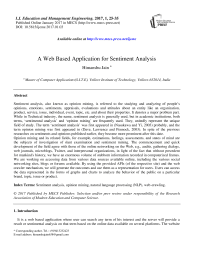A Web Based Application for Sentiment Analysis
Автор: Himanshu Jain
Журнал: International Journal of Education and Management Engineering(IJEME) @ijeme
Статья в выпуске: 1 vol.7, 2017 года.
Бесплатный доступ
Sentiment analysis, also known as opinion mining, is referred to the studying and analyzing of people's opinions, emotions, sentiments, appraisals, evaluations and attitudes about an entity like an organization, product, service, issue, individual, event, topic, etc. and about their properties. It denotes a major problem part. While in Technical industry, the name, sentiment analysis is generally used, but in academic institutions, both terms, 'sentimental analysis' and 'opinion mining' are frequently used. They, unitedly represent the unique field of study. The term 'sentiment analysis' was first appeared in (Nasukawa and Yi, 2003) probably, and the term opinion mining was first appeared in (Dave, Lawrence and Pennock, 2003). In spite of the previous researches on sentiments and opinions published earlier, they become more prominent after this date. Opinion mining and its related fields, for example, estimations, feelings, assessments, and states of mind are the subjects of investigation of slant examination and sentiment mining. The commencement and quick development of the field agree with those of the online networking on the Web, e.g., audits, gathering dialogs, web journals, microblogs, Twitter, and interpersonal organizations, in light of the fact that without precedent for mankind's history, we have an enormous volume of stubborn information recorded in computerized frames. We are working on accessing data from various data sources available online, including the various social networking sites, blogs or forums available. By using the provided APIs (of the respective site) and the web crawler mechanism, we will generate the outcomes and use them as a representation for users. Users can access the data represented in the forms of graphs and charts to analyze the behavior of the public on a particular brand, topic, issue or product.
Sentiment analysis, opinion mining, natural language processing (NLP), web-crawling
Короткий адрес: https://sciup.org/15014047
IDR: 15014047
Список литературы A Web Based Application for Sentiment Analysis
- S. M. Al- Masum, H.Prendinger, and M.Ishizuka, "SensNet: A linguistic tool visualize numerical valence based opinion of text data" in Proceedings of the Int. Conf. on NLP (ICON), pp. 147-152, 2007.
- Bo-Pang, LillianLee, "Opinion Mining and Sentiment Analysis" in Proceedings of the Foundations and Trends in Information Retrieval Vol. 2 Issue 1-2, Jan 2008 Pages 1-135.
- Ronen Feldman, "Techniques and applications for sentiment analysis" in Proceedings of the Communications of the ACM CACM Vol. 56 Issue 4, April 2013 Pages 82-89.
- Minqing-Hu, Bing-Liu, Sentiments features in customer reviews, Proceedings of the 19th Nat. conference on AI, p.755-760, July 25-29, 2004, San Jose, California.
- Turney, Peter (2002). "Thumbs Up or Thumbs Down? Semantic Orientation Apply to Unsupervised Classification of Reviews". Proceedings of the Ass. for Computational Linguistics. pp. 417-424.
- Snyder, Benjamin; Barzilay, Regina (2007). "Multiple Aspect Ranking using the Good Grief Algo.". Proceedings of the Joint Human Language Tech./North American Chapter of the ACL Conference (HLT-NAACL). pp. 300–307.
- Thelwall, Mike; Buckley, Kevan; Paltoglou, Georgios; Cai, Di; Kappas, Arvid (2010). "Opinion strength detection in short text". Journal of the American Society for Information Sci. and Tech. 61 (12): 2544–2558.
- Cataldi, Mario; Ballatore, Andrea; Tiddi, Ilaria; Aufaure, Marie-Aude (2013-06-22). "Good location, terrible food: detecting mood in user-generated reviews". Social Net. Analysis and Mining 3 (4): 1149–1163.
- Dey, Lipika; Haque, S. K. Mirajul (2008). "Sentiment Analysis from Noisy Text Data". Proceedings of the second workshop on Analytics for noisy text data, p.83-90.
- Zhai, Zhongwu; Liu, Bing; Xu, Hua; Jia, Peifa (2011-01-01). Huang, Joshua Zhexue; Cao, Longbing; Srivastava, Jaideep, eds. Constrained LDA for Grouping Product Features in Opinion Mining. Lecture Notes in Computer Science. Springer Berlin Heidelberg. pp. 448–459.
- Titov, Ivan; McDonald, Ryan (2008-01-01). "Modeling Online Reviews with Multi-grain Topic Models". Proceedings of the 17th International Conference on World Wide Web. WWW '08. New York, NY, USA: ACM: 111–120.
- Tumasjan, Andranik; O.Sprenger, Timm; G.Sandner, Philipp; M.Welpe, Isabell (2010). "Predicting Elections with Twitter: What 140 Characters Reveal about Political Sentiment". "Proceedings of the Fourth International AAAI Conference on Weblogs and Social Media".
- Condliffe, Jamie. "Flaming drives online social networks ", NewScientist, 2010-12-07. Retrieved on 2010-12-13.
- CORDIS. "Collective emotions in cyberspace (CYBEREMOTIONS)", European Commission, 2009-02-03. Retrieved on 2010-12-13.
- Roebuck, K. (2012-10-24). Sentiment Analysis: High-impact Strategies - What You Need to Know: Definitions, Adoptions, Impact, Benefits, Maturity, Vendors. ISBN 9781743049457.
- Ogneva, M. "How Companies Can Use Sentiment Analysis to Improve Their Business". Mashable. Retrieved 2012-12-13.
- Galitsky, Boris; McKenna, Eugene William. "Sentiment Extraction from Consumer Reviews for Providing Product Recommendations". Retrieved 18 November 2013.
- Twitter Developers. Doc. Available: https://dev.twitter.com/docs.
- Twitter4j Community members. API Support matrix. Available: http://twitter4j.org/en/api-support.html.
- Christopher D. Manning, Hinrich Schütze: Foundations of Statistical Natural Language Processing, MIT Press (1999), ISBN 978-0-262-13360-9, p. xxxi
- Cambria, Erik; White, Bebo (2014). "Jumping NLP Curves: A Review of Natural Language Processing Research" (PDF). IEEE Computational Intelligence Magazine. 9 (2): 48–57.


